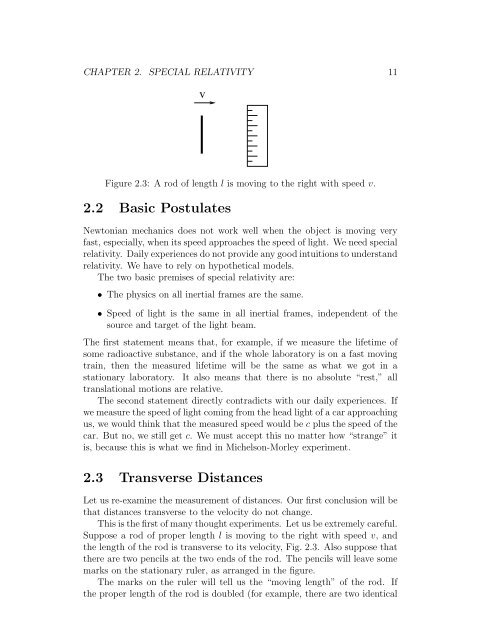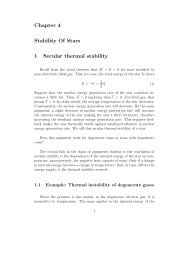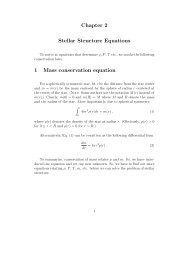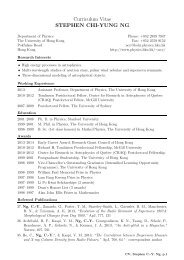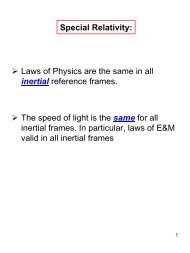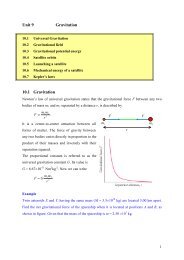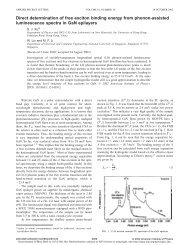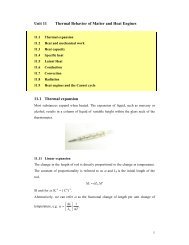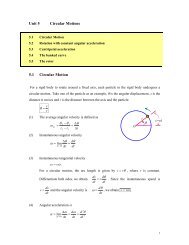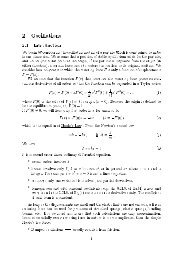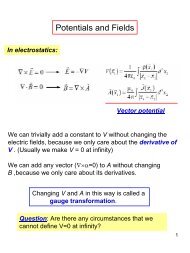here - Department of Physics, HKU
here - Department of Physics, HKU
here - Department of Physics, HKU
Create successful ePaper yourself
Turn your PDF publications into a flip-book with our unique Google optimized e-Paper software.
CHAPTER 2. SPECIAL RELATIVITY 11<br />
v<br />
Figure 2.3: A rod <strong>of</strong> length l is moving to the right with speed v.<br />
2.2 Basic Postulates<br />
Newtonian mechanics does not work well when the object is moving very<br />
fast, especially, when its speed approaches the speed <strong>of</strong> light. We need special<br />
relativity. Daily experiences do not provide any good intuitions to understand<br />
relativity. We have to rely on hypothetical models.<br />
The two basic premises <strong>of</strong> special relativity are:<br />
• The physics on all inertial frames are the same.<br />
• Speed <strong>of</strong> light is the same in all inertial frames, independent <strong>of</strong> the<br />
source and target <strong>of</strong> the light beam.<br />
The first statement means that, for example, if we measure the lifetime <strong>of</strong><br />
some radioactive substance, and if the whole laboratory is on a fast moving<br />
train, then the measured lifetime will be the same as what we got in a<br />
stationary laboratory. It also means that t<strong>here</strong> is no absolute “rest,” all<br />
translational motions are relative.<br />
The second statement directly contradicts with our daily experiences. If<br />
we measure the speed <strong>of</strong> light coming from the head light <strong>of</strong> a car approaching<br />
us, we would think that the measured speed would be c plus the speed <strong>of</strong> the<br />
car. But no, we still get c. We must accept this no matter how “strange” it<br />
is, because this is what we find in Michelson-Morley experiment.<br />
2.3 Transverse Distances<br />
Let us re-examine the measurement <strong>of</strong> distances. Our first conclusion will be<br />
that distances transverse to the velocity do not change.<br />
This is the first <strong>of</strong> many thought experiments. Let us be extremely careful.<br />
Suppose a rod <strong>of</strong> proper length l is moving to the right with speed v, and<br />
the length <strong>of</strong> the rod is transverse to its velocity, Fig. 2.3. Also suppose that<br />
t<strong>here</strong> are two pencils at the two ends <strong>of</strong> the rod. The pencils will leave some<br />
marks on the stationary ruler, as arranged in the figure.<br />
The marks on the ruler will tell us the “moving length” <strong>of</strong> the rod. If<br />
the proper length <strong>of</strong> the rod is doubled (for example, t<strong>here</strong> are two identical


